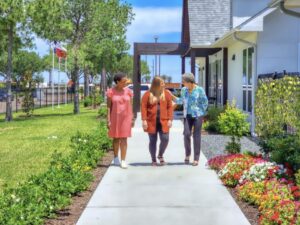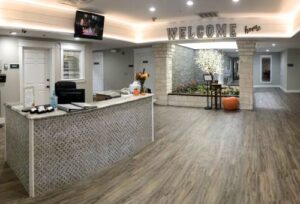
Caring for aging parents can be a challenging but rewarding experience. As parents age, their activities of daily living needs, like bathing, dressing, and eating, may increase, necessitating more assistance and care.
While many families care for their aging parents at home, others may need to consider professional home care services. They can provide various services, from personal care and assistance with daily routine to medical care and support for chronic conditions. In this article, we will critically examine home care services for aging parents.
Understanding Home Care Services
Statista reported in 2023 that in 2022, 17.3% of the American population was 65 or older. This figure is projected to rise to 22% by 2050, reflecting the ongoing demographic shift toward an aging population in the country. The data underscores the importance of home care services in present and future contexts.
Home care services have emerged as a lifeline for many families dealing with the complexities of aging. At its core, it involves providing assistance and support to elderly individuals in the comfort of their own homes.
This form of care is highly individualized, catering to the unique needs and preferences of each senior. It can encompass a wide spectrum of services, making it a versatile solution for various situations.
The Advantages of Home Care
These services offer several key advantages, including the convenience of receiving care at home, which can be less stressful. It provides flexibility with tailored services, schedules, and personalized one-on-one care, ensuring individual needs are met. Also, it promotes independence and allows clients to maintain their dignity by making decisions about their care.
In addition to these advantages, it can be more cost-effective than other care options. According to the Genworth Cost of Care Survey, in 2021, the median monthly cost of home care was $4,957. In contrast, a private room in a nursing home averaged $9,034, while a shared room cost $7,908.
This data highlights the cost savings linked to home care, rendering it a financially appealing choice for families tending to elderly parents.
According to Always Best Care Senior Services, seniors often value the independence of living in their own homes. However, it can become lonely when they lack regular visits from family and friends. In-home caregivers offer valuable companionship to mitigate this isolation.
The Challenges
These services come with several significant challenges. Ensuring the quality of care relies on caregiver competence and reliability, requiring vigilant vetting and monitoring. Caregiver burnout is a real concern as family caregivers juggle their lives and careers with caregiving responsibilities.
Seniors may experience social isolation, missing the communal aspects of senior living facilities. While basic medical services are offered, complex medical needs may necessitate additional resources. Also, the cumulative cost of the service can strain seniors and their families financially.
Evaluating Your Parent’s Needs
A study conducted by AARP in 2021 found that approximately 77% of seniors prefer to age in their homes. However, many seniors eventually need some level of assistance with activities of daily living. This data underscores the significance of assessing and addressing their unique needs to facilitate this desire for aging in place.
Therefore, before making decisions regarding home care services for parents, it is paramount to thoroughly assess their specific needs. Understanding their requirements and preferences will guide you in selecting the most appropriate level of care.
To evaluate your parent’s needs, a structured approach is vital. Commence with a thorough medical assessment conducted by a healthcare professional, considering health conditions and medication management. Assess their capacity to perform daily tasks like bathing, dressing, meal preparation, and more complex activities, including managing finances and transportation.
Finding Quality Home Care Providers Nearby
When it comes to caring for aging parents, finding quality home care providers nearby is of paramount importance. The proximity of services ensures assistance is readily available in case of emergencies. It also enables regular, attentive care for your loved ones.
To illustrate the significance of this, consider the case of Lincoln Williams. The 76-year-old went missing from the 16300 block of Calistoga Court in Houston last year.
As reported by ABC13, this incident underlines the challenges faced by seniors dealing with memory loss and dementia. Fortunately, a Silver Alert was canceled after he was found safe in southwest Houston, thanks to the efforts of local authorities and caregivers.
In situations like these, where individuals may experience memory loss or cognitive challenges, the presence of a home care nurse can be invaluable. You can find many options for nurses providing home care in Woodlands, Spring, Houston, or other adjacent areas. These dedicated professionals are well-equipped to offer specialized care for elderly individuals, ensuring their safety, well-being, and a higher quality of life.
When seeking services in your area, start with recommendations from friends, family, or local healthcare professionals for trusted agencies. Conduct online research to explore websites, qualifications, and client feedback. Schedule visits to agencies to assess professionalism and care quality.
Ensure agencies have the necessary licensing and accreditation. Besides, interview potential caregivers, assessing their qualifications, experience, and compatibility with your loved one’s needs.
Alternatives to Home Care
There are several alternatives to home care, each one catering to different senior care needs. Assisted living communities provide many services, making them suitable for seniors requiring some assistance while preserving independence. Nursing homes offer around-the-clock skilled nursing care for those with complex medical needs.
Adult daycare centers provide daytime supervision and activities for seniors who seek engagement. Family caregivers can also provide care; however, they must recognize the demands and ensure a support system and breaks are in place. However, when choosing an alternative, it is crucial to consider the needs of the seniors and their families.
The American Senior Communities reported that in 2020, there were approximately 28,900 assisted living communities in the United States. These communities boasted nearly 1 million licensed beds, with an average size of 33 beds. Altogether, there were approximately 811,500 residents residing in these facilities nationwide. The data emphasizes the growing importance of these alternatives.
Making an Informed Decision
Deciding whether or not home care is right for your parent is a complex one. There are several factors to consider, including their needs, your family’s financial situation, and your availability.
It is important to weigh the benefits and challenges carefully. It can offer several advantages, such as convenience, flexibility, and personalized care. However, it can also be expensive and challenging to manage.
If you are considering the services, it is necessary to do your research and choose a reputable provider. You should also talk to your parent about their preferences and make the best decision for everyone involved.
To Wrap it Up
Caring for aging parents is a profound journey that demands careful consideration and a critical evaluation of the available options. Home care services have emerged as a valuable solution, offering the comfort of aging in place and personalized care. Recognize the complexities and challenges associated with these services, including thorough vetting, caregiver burnout, and seniors’ emotional well-being.
The decision to provide care is deeply personal and carries profound emotional weight. By thoughtfully assessing their needs and considering available options, you can confidently provide the best care for your loved ones. In this intricate process, your unwavering commitment and dedication to their well-being are the foundation for the path to dignified aging.









